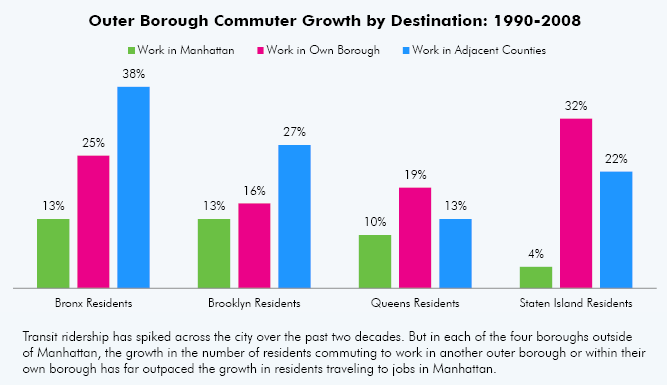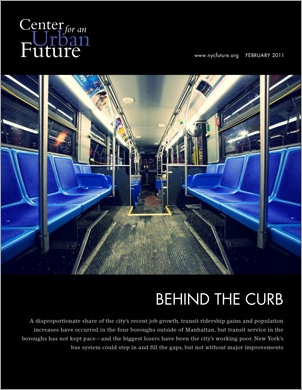The following is the introduction. Click here to read the full report (PDF).
As the country’s largest and densest metropolis, New York City has historically offered a level of public transit service that most other cities could only dream about. Commuting to Manhattan’s central business districts has been, and still is, a remarkably easy affair for hundreds of thousands of residents, whose travel options include commuter train, subway, ferry and bus. However, the city has changed dramatically since most of these services were introduced, and more and more residents, particularly lower-income workers, are no longer traveling to Manhattan for work.
Over the last two decades, the other four boroughs have been steadily growing their own vibrant job centers, in neighborhoods like Flushing, Queens, and East Flatbush, Brooklyn. Consequently, the number of commuters who travel to work in their own boroughs or to neighboring boroughs or counties has been growing much faster than the number of commuters who make the more traditional trip into Manhattan. For example, in the Bronx, the number of commuters traveling to Queens and Westchester County grew by 38 percent between 1990 and 2008, whereas the number going to Manhattan increased by just 13 percent in the same time period. Similarly lopsided numbers hold for Brooklyn, Queens and Staten Island.
If New York is going to retain a world-class public transportation system and sustain job growth outside of Manhattan, it must invest in solutions that make these less traditional commuter trips easier for passengers. The median travel time to work has been steadily rising in New York for more than two decades. Although long commutes affect every income group, low-income workers suffer the most by far: Of those residents with an hour or longer commute, two thirds earn less than $35,000 per year.
Fortunately, relatively inexpensive changes to the city’s underperforming bus system, if done right, can plug many of the holes in the city’s existing transit network and vastly improve the quality of life of many working poor New Yorkers. The Metropolitan Transit Authority (MTA) and the New York City Department of Transportation (DOT) have taken tentative steps to improving bus service, but to make a real mark the city and state must think bigger. Legislators need to settle on a sustainable funding stream for the MTA and commit to supporting both small and large-scale improvements to the city’s much-maligned bus system, from elevated platforms and time-arrival technology to divided bus lanes and attractive stations. The MTA and the DOT should create a Bus Rapid Transit (BRT) system for New York that builds off of those emerging in other cities across the U.S. and around the world: a network of buses that look and function more like subways, with routes that travel between boroughs to facilitate nontraditional commutes.
* * *
This report takes an in-depth look at transportation challenges facing low-income New Yorkers. It considers how improvements to the city’s bus system could improve the lives of the poor and working poor while simultaneously helping to sustain economic growth in areas of the city that are poorly served by transit. The report draws upon extensive economic and demographic analysis and more than 60 interviews with transportation experts, economic development officials, community organizers and business leaders, as well as large and small employers sparking job creation across the city. Because the voices of the poor are notably missing from most policy discussions on transit, we made a point of reaching out to this community and interviewed dozens of advocates for the poor and city residents who live in neighborhoods with little or no public transit access.
People we spoke with were nearly unanimous in saying that transportation posed a big challenge for the working poor in New York, despite the fact that transportation has not traditionally been perceived as a priority issue for this community. Most of the low-income residents we interviewed rely on the bus to get out of their neighborhoods and complain of multiple transfers and long, undependable commutes. At the Andrew Jackson Houses in the Melrose section of the Bronx, for example, tenant association leader Danny Barber estimates that at least 75 percent of residents use the bus every day. The 4 train is about ten blocks, or a little more than a half mile, from the complex. But, according to Barber, most of the residents with jobs travel across the borough or north to points along East Fordham Road; and those bus trips, he says, are much more complicated than the commute to Manhattan.

At the Castleton Park Houses in St. George, Staten Island, almost all residents similarly depend on the bus, says tenant association leader Sharon Valentin. They ride the bus to the Ferry Terminal and either take the ferry to Manhattan or transfer to another bus. If the latter, says Valentin, they’re almost certainly in for a frustrating ride. “Getting anywhere on Staten Island is harder than getting to Manhattan if you don’t own a car,” she says. “We have a new Target on the other side of the island and the bus lets you off a half a mile away. I know a lot of people here who would like to work at that Target, but getting there every day is too hard.”
As our research shows, these are not isolated cases. For the past two decades, the number of New York City residents—of all income groups—who travel to work either within their own borough or to a neighboring borough or county has been increasing much faster than the number who make the more traditional trip into Manhattan. Commuters who rely on public transit have had to depend more and more on city buses, and commute times have gotten longer as a result.
As shown in the graph on page 5, a shift in commuter destinations is prevalent in all four boroughs outside of Manhattan, although it is undoubtedly strongest in the Bronx and Staten Island. While a large percentage of outer borough residents still work in Manhattan, between 1990 and 2008 the number of Bronx residents who travel to Queens or Westchester County for work grew by 38 percent and the number who travel inside the borough jumped by 25 percent; in the same period, the number commuting to Manhattan increased by just 13 percent. Similarly, in Staten Island, the number of residents who travel to work in their own borough increased by 32 percent between 1990 and 2008; those going to Brooklyn or New Jersey increased by 22 percent; while the number traveling to Manhattan barely changed at all—a four percent increase in those 18 years. Brooklyn and Queens both saw significant gains in non-traditional commutes as well. In fact, the number of Brooklyn residents traveling to Queens grew by 32 percent since 1990, compared to a 13 percent increase in commuters going to Manhattan.1 Today, nearly 160,000 people cross the Brooklyn/Queens border for work every day.
One big reason for this shift in commuter patterns is the city’s changing economic landscape. During the economic boom between 2003 and 2008, Brooklyn had a bigger percentage increase in jobs than Manhattan did. During the recession of 2008–2009, the Bronx gained 3,647 jobs—the only borough to add jobs during this period; by contrast, Manhattan lost 100,799 jobs in that one year. Driving growth in every borough were gains in health care and education. Between 2000 and 2009, New York City gained nearly 120,000 jobs in those two sectors alone. And although midtown Manhattan has several prominent hospitals and universities, collectively, the hundreds of hospitals, nursing homes, community health clinics, colleges and professional schools in the other four boroughs—from Montefiore Hospital in the Bronx and SUNY Downstate Medical Center in Brooklyn to Queensborough Community College in Bayside—accounted for the lion’s share of jobs in those sectors.
New York City’s transit system wasn’t designed for commuter trips to jobs within and between boroughs outside of Manhattan, and, partly as a result, the city’s median commute times have been climbing for decades. They are now among the highest of any major city in the country. For public transit riders in the boroughs, they range from 52 minutes each way in Brooklyn to 69 minutes each way in Staten Island. “The transit system is all optimized as if everybody works in midtown Manhattan, south of 59th Street,” says Jonathan Peters, a transit expert at the College of Staten Island. “The MTA seems to be under the impression that all the job growth in the city is still occurring in the Manhattan CBDs [central business districts], but it’s not. In Staten Island’s case, the new commuter trips are all going to New Jersey and Brooklyn.”
As more and more residents have started to travel to work outside of Manhattan, the city’s bus system has come to play a much more important role in the transit network. According to the MTA, bus ridership has increased by 60 percent since 1990, and transit planners believe that future increases of 30 percent or more per decade are a reasonable, even conservative assumption. Yet because of the increase in ridership as well as increased traffic congestion on city roads, the quality of service on city buses has been declining steadily for years. Between 1996 and 2006, average bus speeds in New York slowed by 11 percent, from 9 mph to 8 mph, one of the slowest average bus speeds in the country.2 Moreover, buses regularly fail to keep a schedule. The same trip can take 30 minutes one day and 50 minutes the next, which makes it difficult for riders to budget their time.



